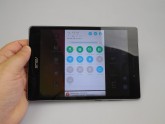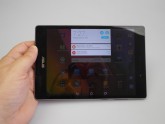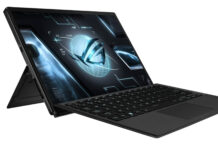The ASUS ZenPad S 8.0 is a tablet that was unveiled by ASUS at this summer’s Computex 2015 and seemed pretty impressive back then. Now we received the slate for testing, in the Z580CA version, complete with a slim design and 4 GB of RAM. The product is a rival for the Nokia N1, iPad Mini 4 and Galaxy Tab S models and it’s priced at $199 in the 2 GB RAM version or $299 for the 4 GB RAM one.
The product comes in black or white and it brings a chassis that’s only 6.6 mm thick. This is slimmer than the Nokia N1’s 6.9 mm, but thicker than the 6.1 mm of the iPad Mini 4 or the crazy thin 5.6 mm of the Galaxy Tab S2 8.0. ZenPad S 8.0 weighs 298 grams, which is 1 gram lighter than the iPad Mini 4 and quite a big lighter than the Nokia N1’s 318 grams. Galaxy Tab S2 8.0 remains lighter, at 265 grams.
Inspired by the world of fashion, the ASUS tablet has a brushed aluminum imitation back, combined with a section that imitates leather and expands to the edges. In reality they’re both plastic, with the brushed metal imitation having an actual metal edge that’s diamond cut and shiny. The faux leather offers excellent grip and this gadget is comfy to hold even for long periods of time and even with one hand.
Bezels are quite big for 2015 and the only bad thing here are the plastic edges, that feel fragile, especially if the device is thrown in a schoolbag next to a solid object, that may chip its edges. Upfront we find two speakers, front camera and sensors, while at the back there’s the slightly protruding main camera and a criss cross pattern on the metal imitation plate. The Intel logo was already wiped from the faux leather part after a few touches with a more or less sweaty hand.
At the top there’s the audio jack, while at the bottom rests the USB Type C port, that’s been moved from the center to a side, so it could help with the tablet’s landscape usage. Here we also find the microphone and I noticed that this slate has slightly rounded edges. On the left side there’s the microSD card slot with a lid on top, while on the right we’ve got volume buttons and a Power button, with OK feedback,
Overall, this is an elegant product, but not made of metal and a bit fragile, but also very comfy to use. As far as hardware goes, we’re getting an 8 inch screen here, at least according to ASUS, but I measured it and found it’s actually a 7.87 inch display, so they rounded it up quite a bit. The display offers a resolution of 2048 x 1536 pixels and uses Gorilla Glass 3 protection, while the rest of the specs includes an Intel Atom Z3580 quad core CPU, clocked at 2.3 GHz, the same 64 bit unit from the Nokia N1.
Also on board there’s the PowerVR G6430 GPU, at 533 MHz, 4 GB of LPDDR3 dual channel RAM (64 bit) and 16, 32 or 64 GB of storage, as well as a microSD card slot with support for an extra 128 GB. There’s another version of this slate that comes with 2 GB of RAM and Z3560 CPU by the way. We also get 5 GB of ASUS WebStorage in the cloud, coupled with 100 GB of Drive storage from Google for 2 years.
The cameras offered here are an 8 megapixel back unit and a front 5 MP shooter. On the connectivity side, there’s WiFi 802.11 a/b/g/n/ac, Bluetooth 4.1, Bluetooth Smart, Miracast, USB Type C, GPS and Glonass. Finally the hardware includes two DTS HD speakers, a G Sensor, E Compass, light sensor and hall sensor. The battery on board of the Z580CA is a 15.2 Whr one (Li-Po), that on paper provides 8 hours of video playback with brightness at 100 nits.
We achieved a time of 6 hours and 50 minutes of HD video playback in a loop, with WiFi on and brightness at 200 LUX, which is reasonable, but it doesn’t beat any rival. For example, the Nokia N1 reaches 8 hours and 32 minutes of playback, while the Xiaomi Mi Pad goes to 10 hours, the iPad Mini 2 offers 10 hours and 8 minutes and the Galaxy Tab S 8.4 achieves 13 hours and 33 minutes.
At least we beat the Chuwi Vi8, with its 5 hours and 58 minutes. In the PCMark test, that simulates continuous usage, ASUS ZenPad S 8.0 gave us 4 hours and 59 minutes of functioning time. Thus, we beat the Galaxy Tab S 8.4 and its 4 hours an 43 minutes, as well as the ZenPad 7.0 and its 4 hours and 19 minutes, or the Chuwi Vi8 and its 3 hours and 29 minutes.
We scored below the Nokia N1, that achieves 7 hours in PCMark and the Xiaomi Mi Pad, that reaches 6 hours and 28 minutes. Once again, a reasonable time, but not impressive. The charging takes 3 hours and 24 minutes, which is quite a bit, but it’s better than the Nokia N1’s 3 hours and 52 minutes or the iPad Mini 2’s 3 hours and 40 minutes. Still, the rival scored better, like the Xiaomi Mi Pad, charging in 2 hours and 30 minutes, the Galaxy Tab S 8.4 in 3 hours or the ZenPad 7.0 in 2 hours and 16 minutes.
Settings include a Power Save option, with an Optimized Mode and an Ultra Saving Mode, that limits performance and background data. Then there’s also the custom mode, that set the percentage of the power saving start, reduces brightness and push notifications. Now we move on to audio, where the tablet offers DTS HD technology and Sonic Master tech, too. We get two front facing speakers here and support for 360 degree surround in headphones.
The music app is minimal and typical for Zen UI and the Settings include both a sleep timer and an equalizer, with a Fine Tune option that has a trippy disco interface. You can set up the volume from here, the bass, treble and enhance dialog in movies, plus tweak the sound with 5 custom channels with sliders. You can opt for the Android stock EQ or the ASUS Audio Wizard one.
The actual listening experience was loud and clear, also pleasant and not one bad note was heard. The bass was also good and Audio Wizard (the app) includes the usual options like Movie, Music, Gaming, Vocal and Smart, but now it has a new UI. There’s also the Advanced Effect area, that brings you back to the same EQ. Audio is good overall, but our decibelmeter didn’t think so, because it showed a value of 79.3 dBA at the front and 76.5 dBA at the back, which is weaker than expected.
The Nokia N1 for example scores 89.8 dBA, while the Xiaomi Mi Pad achieves 83.3 and the Galaxy Tab S 8.4 84.5 dBA. Still, we beat the Allview Viva H7 Xtreme and its 74.3 dBA or the Chuwi Vi8 and its 71.6 dBA. Once again, in real life the speakers behave much better than in this test. As far as the screen is concerned, we’re dealing with that 7.87 inch IPS LCD unit we mentioned above, with LED lighting and a 2048 x 1536 pixel resolution.
Gorilla Glass 3 is also here, plus an anti fingerprint coating and full lamination technology and palm rejection for the stylus. This is a 4:3 display, with 74% screen to body ratio and coming with a few technologies you may find useful, like the ASUS Visual Master, that brings viewing experience enhancements, or the ASUS Tru 2 Life technology, that brings TV imagine processing to the small screen and offers accurate contrast and realistic images.
ASUS also claims it offers here intelligent contrast, sharpness optimization and TruVivid technology, that uses two screen layers instead of 4 for extra clarity, improved brightness and touch response. Then there’s the ASUS Blue Light Filter, that reduces eye fatigue and the promise of 178 degree view angles and 20 ms touch response. The gallery is used as the video player and the viewing experience offered us cold colors, not a very bright screen, bad sunlight behavior and wide view angles.
The frame rate was good and the image was crisp, though. Pixels are of the RGB Stripe kind and the luxmeter showed us a value of 257 LUX, which is very low for this product. Even the cheaper ZenPad 7.0 scores 274 LUX, not to mention the 310 LUX of the Xiaomi Mi Pad, the 355 LUX of the Nokia N1, 412 LUX of the iPad Mini 2 and 432 LUX of the Galaxy Tab S 8.4.
By the way, the ASUS made Nexus 7 2013 scored 500 LUX back in the day, so it’s strange to see such low brightness in 2015. Settings for the screen allow us to tweak fonts and the screen color mode, with a color temperature slider, options for balanced viewing, blue light filter and custom hue and saturation tweaks. Then there’s an option that lets you made video playback more fluid and blur free, with 4 options (high, middle, low, disabled).
Overall, the screen would be OK, if it weren’t for that low brightness and contrast. And now… the cameras! This device brings an 8 MP + 5 MP combo (back and front), with PixelMaster technology and F/2.0 aperture. The 5 MP shooter has an 85 degree wide angle lens and can take panoramic selfies. The UI offers options like white balance, ISO, exposure, optimization, resolution (8 MP in 4:3 or 6 MP in 16:9), anti shake, image quality (fine, standard), but also focus options (smart AF, continuous AF, or infinity).
Video can also be set to Full HD or HD and you can activate digital image stabilization, that will only be available with HD filming. Other options include Performance or Quality for video capture and then we move on to the capture modes, that are as follows: Auto, HDR, Beautification, Super Resolution, Low Light, Night, Depth of Field, Effect, Selfie, GIF, Panorama, Miniature, Time Rewind, Smart Remove, All Smiles, Slow mo and Time Lapse.
Beautification has tweaks for the eyes and face, while Super Resolution combines 4 shots into 32 megapixels shot. Depth of field creates nice closeups, while the rest are already known from the days of the ZenFones. The front camera offers a wide selfie feature and as far as the camera experience is concerned, we noticed the focus was fast, zoom was fluid and once the screen was kept pressed the AF/AWB/AF frame appeared, with an exposure slider bundled.
Picture taking is reasonably fast for a tablet. We also have a gallery of shots here, with OK quality once again for a slate, good colors and a slight tendency to overexpose frames. The image is crisp and I’d say it can match the quality of the Nokia N1 and Xiaomi Mi Pad, but it’s below the performance of the iPad Mini 2 or Galaxy Tab S 8.4. Shots were taken on a very cloudy day and we had some good closeups, but also grainy indoor shots.
The capture is reasonable in low light, especially considering there’s no flash. Videos capture had some acoustics problems, with a lot of echo, exposure problems too, but an OK focus and colors. They were also shaky and the slow mo capture looked nice. The stabilized 720p was very bad, even worse than 480p clips. Bitrate was 15 Mbps for a Full HD 30 FPs video.
Overall the camera was reasonable for a tablet and moving on to editing, we’ve got options related to eyes, skin and other things (for selfies), plus the usual filters, frames, crop, draw, blur, saturation, hue and exposure options. We tested the temperature after playing 15 minutes of the game Riptide GP2 and reached a value of 35 degrees Celsius, which means the device doesn’t overheat.
The web browser was fast and featured a Trending section, while the keyboard was comfy and had an useful numeric row and Swype support, plus voice command. We also did some benchmarks here, comparing the ZenPad S 8.0 with the Nokia N1, Xiaomi Mi Pad, iPad Mini 2 and Galaxy Tab S 8.4. This is a battle between the Intel Atom Z3580 and 4 GB of RAM, versus the Intel Atom Z3580 and 2 GB RAM, Tegra K1 and 2 GB of RAM, Exynos 5420 and 3 GB of RAM and the Apple A7 and 1 GB of RAM.
Here are the results:
The device only wins 1 out of 11 duels, which is bizarre, especially since the Nokia N1 has the exact same specs, plus twice as little RAM. At least we beat the Galaxy Tab S 8.4 in 8 out of 11 tests. ZC580CA doesn’t suffer from lag and runs games with 3D graphics like Riptide GP2 just fine. Now let’s talk about the OS and UI. We’re dealing with Android 5.0 Lollipop here, with the latest Zen UI on top and if you’ve seen a ZenFone over the past year, you know what to expect.
The UI is colorful, flat and has Material Design influences. ASUS also offers more varied widgets than the competition, aside from stock ones. Once you keep the homescreen pressed, a wide palette of options appears, including an Apps and Widgets section, preferences for one or two homescreen layers, editable homescreens, wallpapers, icon packs, scroll effects, app locking and more.
The Recents button triggers a multitasking carousel, that also has shortcuts to running services and screen pinning. The dropdown area features the typical notifications and big iconography for quick settings, as well as the brightness slider. The Settings include Zen Motion (double tap to wake, draw letters on lockscreen to open ups etc), Do Not Disturb features, Z Stylus options and ASUS Customized Settings, that for example associate keeping the Recents button pressed with taking a screenshot. Then there’s Easy Mode, Security options and Zen UI app updates.
The preinstalled app list is filled to the brim with bloatware and it’s quite a huge list. Zen UI feels like the new old TouchWiz, but without lag. I noticed that the tablet will automatically transfer apps to dedicated folders, sensing they’re games, social networking or productivity apps. And the list goes like this:
Clean Master
Amazon Kindle
Free Games
Tripadvisor
Contacts
Email
Omlet Chat
The Google app suite
Photo Collage
Calculator
Calendar
Do It Later
Share Link
What’s Next
Web Storage
ASUS Support
Auto Start Manager
Backup
File Manager
Mirror
PC Link
Power Saver
Quick Memo
Remote Link
Sound Recorder
Splendid
Supernote
System Update
Data Transfer
Voice Search
Kids Mode
Live Water
Mini Movie
My ASUS
Weather
Zencircle
Zinio
Street View
Play Games
Do It Later is basically a list of to do activities in the near future, where you can add web pages, mails and notes for example straight from the dedicated apps. What’s next is a longer timeline, with calendar integration, weather and VIP contacts. Supernote has evolved into a very solid note taking app, with a varied clipart, lots of tips for the virtual pen, drawing and doodling features and it can easily rival the Samsung S Note now.
And now it’s time for the verdict!
Here are the Pros:
slim, light and comfy tablet
elegant design
good audio in spite of decibelmeter
decent picture taking
good performance in games and productivity apps
And the Cons:
underwhelming battery
not very bright screen
bad contrast
low benchmarks compared to other models with lower specs
lots of bloatware
too many options, settings and gimmicks
feels fragile
poor filming compared to photo taking
cold colors
This model suffers from a bit of “Apple syndrome”, with too many concepts and ideas promoted around it, stuff like Pixelmaster, Truvivid, Tru2Life, Blue Light Filter, DTS HD and Sonic Master messing with your head and making you expect too much. Underneath it all and underneath dozens of apps there’s a solid tablet, with a not so good screen and battery. I see this tablet as less impressive than the Nokia N1, but above the Nexus 9, for example.
We give it a 9 for design, an 8.5 for hardware and an 8.7 for OS and UI. The final grade is 8.73 out of 10 and this device is good for gaming and video consumption, plus work if you have a keyboard and stylus for it. Too bad for the screen and bloatware, plus the plastic edges.
[youtube 8z2YFOpMiX4 660 371]
Post Footer automatically generated by Add Post Footer Plugin for wordpress.








































































